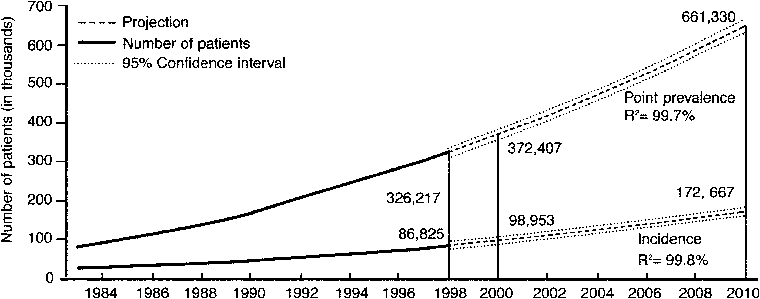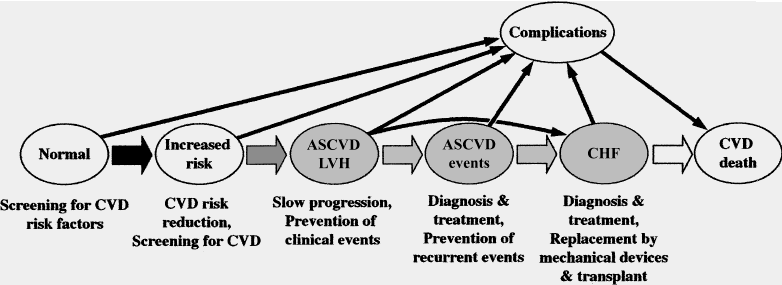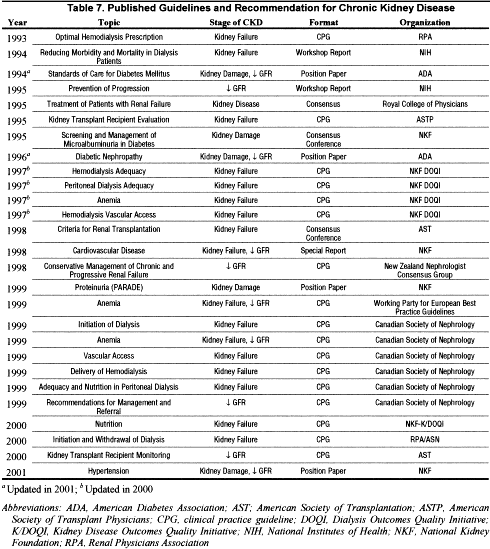NKF KDOQI GUIDELINES
KDOQI Clinical Practice Guidelines for Chronic Kidney Disease: Evaluation, Classification, and Stratification
PART 2. BACKGROUND
NKF KIDNEY DISEASE OUTCOMES QUALITY INITIATIVE (KDOQI)
SINCE THEIR publication in the Fall of 1997, the National Kidney Foundation (NKF) Dialysis Outcome Quality Initiative (DOQI) Guidelines have become an integral part of nephrology practice throughout this country and in many parts of the world. It is widely acknowledged that the DOQI Guidelines have had an impact in improving quality of care and outcomes of patients treated by dialysis. In the Fall of 1999, the NKF decided to focus its attention on the millions of people with earlier stages of chronic kidney disease, who through early diagnosis and treatment, could possibly avoid the progression of their disease to development of kidney failure and other adverse outcomes. The goal of this new initiative, the Kidney Disease Outcomes Quality Initiative (KDOQI), is to improve the quality of care and outcomes of all individuals with kidney disease by developing clinical practice guidelines for the management of patients in earlier stages of kidney disease. This guideline, Chronic Kidney Disease: Evaluation, Classification and Stratification, will serve as the foundation for future guidelines by standardizing the definition and classification of stages of chronic kidney disease, laboratory evaluation of kidney disease, association of the level of kidney function with complications, and stratification of risk for adverse outcomes of kidney disease. Future guidelines will focus on diagnosis and treatment of complications of earlier stages of kidney disease, ameliorating its complications, retarding the progression of the disease, reducing the morbidity and mortality of cardiovascular disease, and reducing the morbidity and mortality of kidney failure. The ultimate objectives are to improve the quality of care and outcomes of all individuals with kidney disease and to reduce the risk of developing kidney disease.
The Problem
Chronic kidney disease is a worldwide public health problem. In the United States, there is a rising incidence and prevalence of kidney failure, with poor outcomes and high cost. The incidence and prevalence of end-stage renal disease (ESRD) have doubled in the past 10 years and are expected to continue to rise steadily in the future.
Figure 2 |
Incidence and prevalence of end-stage renal disease in the United States. Incident patients refers to new cases during the year. Point prevalent patients refers to patients alive on December 31st of the year. Solid vertical lines represent complete data for 1998 and expected data for 2000. Projections for future years are based on extrapolation of regression equations. R2 for regression equations is given. Data from USRDS 2000 Annual Data Report.4 |

|
Data from the 2000 Annual Data Report of the US Renal Data System (USRDS) documents the incidence of ESRD in 1998 of more than 85,000, or 308 per million individuals per year at risk. The point prevalence of ESRD on December 31, 1998 was more than 320,000, or 1,160 per million population, of whom 72% were treated by dialysis and 28% had functioning kidney transplants.
Despite advances in dialysis and transplantation, the prognosis of kidney failure remains bleak. The USRDS reports more than 63,000 deaths of patients with ESRD in 1998, and an annual mortality rate of dialysis patients in excess of 20%. Expected remaining lifetimes of patients treated by dialysis were far shorter than the age-matched general population, varying (depending on gender and race) from 7.1 to 11.5 years for patients aged 40 to 44 years, and from 2.7 to 3.9 years for patients aged 60 to 64 years. Morbidity of kidney failure is also high. The mean number of comorbid conditions in dialysis patients is approximately 4 per patient, the mean number of hospital days per year is approximately 15, and self-reported quality of life is far lower than the general population. Total Medicare and non-Medicare costs for ESRD treatment in 1998 were $12.0 billion and $4.7 billion, respectively. There is an even higher prevalence of earlier stages of chronic kidney disease. Mortality, morbidity, hospitalizations, quality of life, and costs for caring for patients with earlier stages of chronic kidney disease have not been systematically studied.
Historically, the evaluation and management of chronic kidney disease has focused on diagnosis and treatment of specific kidney diseases, and dialysis or transplantation for kidney failure. Increasing evidence, accrued in the past decades, indicates that the adverse outcomes of chronic kidney disease can be prevented or delayed through interventions during earlier stages of chronic kidney disease, irrespective of the cause. Unfortunately, chronic kidney disease is “under-diagnosed” and “under-treated” in the United States. This leads to lost opportunities for prevention of complications and worse outcomes for patients with chronic kidney disease.
Strategies for Early Detection and Intervention
Earlier stages of kidney disease can be detected through laboratory testing. Measurement of serum creatinine and estimation of GFR can identify patients with reduced kidney function. Measurement of urinary albumin excretion can identify some, but not all, patients with kidney damage. Screening asymptomatic individuals at increased risk could allow earlier detection of chronic kidney disease.
Currently, the US Preventive Health Services Task Force does not recommend urinalysis or measurement of serum creatinine in otherwise healthy adults. Until recently, recommendations for screening for chronic kidney disease in adults were largely focused on patients with hypertension. A recent analysis of the NHANES III database indicated that only 70% of individuals in the United States with elevated serum creatinine had hypertension.5 More recent guidelines by the NKF–Proteinuria, Albuminuria, Risk Assessment, Detection, and Elimination (PARADE)6,7 and the American Diabetes Association8 recommend periodic evaluation of all individuals at increased risk for kidney disease and those with diabetes for albuminuria. Appropriate measurement and interpretation of urine albumin and serum creatinine in all individuals with hypertension and diabetes could identify a large number of patients with earlier stages of chronic kidney disease. However, it is likely that evaluation programs targeting only individuals with hypertension and diabetes will miss a large number of individuals with other causes of chronic kidney disease. Testing criteria could be expanded beyond just diabetes or hypertension, as recommended in the NKF-PARADE position paper.
Therapeutic interventions at earlier stages of chronic kidney disease are effective in slowing the progression of chronic kidney disease. The major therapeutic strategies that have been tested include strict blood glucose control in diabetes, strict blood pressure control, angiotensin-converting enzyme (ACE) inhibitors and angiotensin-receptor blockers, and dietary protein restriction. The study of kidney diseases in the transplant population has long focused on prevention and treatment of allograft rejection. Thus far, no large-scale clinical trials of kidney transplant recipients have evaluated therapies that are effective in slowing progression of diseases in native kidneys. However, within the past few years, observational studies have demonstrated that non-immunological factors, such as proteinuria and higher blood pressure, appear to be risk factors in diseases of transplanted as well as native kidneys.
Conceivably, treatment of CVD risk factors in earlier stages of chronic kidney disease could reduce adverse outcomes of cardiovascular disease before and after development of kidney failure. However, few patients with chronic kidney disease have been included in population-based epidemiological studies of cardiovascular disease or long-term, randomized clinical trials. Therefore, the NKF Task Force on Cardiovascular Disease developed an evidence model for cardiovascular disease in chronic kidney disease and developed criteria for extrapolation of evidence on the efficacy of risk-factor reduction therapies from the general population to patients with chronic kidney disease.
Figure 3 |
Evidence model for stages in the initiation and progression of cardiovascular disease, and therapeutic interventions. Shaded ellipses represent stages of cardiovascular disease; unshaded ellipses represent potential antecedents or consequences of CVD. Thick arrows between ellipses represent factors associated with initiation and progression of disease that can be affected or detected by interventions: susceptibility factors (black); initiation factors (dark gray); progression factors (light gray); and end-stage factors (white). Interventions for each stage are given beneath the stage. Individuals who appear normal should be screened for CVD risk factors. Individuals known to be at increased risk for CVD should be screened for CVD. Modified and reprinted with permission.9 |

|
In general, the Task Force concluded that most interventions that are effective in the general population should also be applied to patients with chronic kidney disease. The NKF has initiated two other KDOQI Work Groups that are developing clinical practice guidelines for the evaluation and management of specific cardiovascular disease risk factors in defined target populations with chronic kidney disease. These will be available in the near future. In addition, other professional organizations are focusing on other risk factors or other target populations.
Overview of Current Status of Treatment for Chronic Kidney Disease
It is difficult to evaluate the current status of treatment for chronic kidney disease. A systematic search yielded few guidelines for diagnosis and management of earlier stages of chronic kidney disease.

While the USRDS is charged with compiling and reporting data on incidence, prevalence, outcomes, and cost of dialysis and transplantation, patients with earlier stages of chronic kidney disease are not systematically tracked by any public health agency in the United States. In addition, standards of care have not been defined in a universally accepted format. Therefore, there is no ongoing effort to ascertain adherence to standards for care or outcomes for patients with earlier stages of chronic kidney disease. The National Institute for Diabetes, Digestive and Kidney Disease is beginning a prospective cohort study of patients with decreased GFR to determine factors that are associated with adverse outcomes of chronic kidney disease. However, even in the absence of such studies, there is substantial evidence of “under-diagnosis” and “under-treatment.”
Analysis of data from NHANES III on the adequacy of drug treatment of hypertension in patients with elevated serum creatinine revealed that only 75% of patients with hypertension and elevated serum creatinine had received treatment.5 However, only 11% had their blood pressure reduced to <130/85 mmHg, the level recommended by the Sixth Report of the Joint National Committee on the Prevention, Detection, Evaluation and Treatment of High Blood Pressure (JNC VI), and the NKF to slow the progression of chronic kidney disease. Only 27% had their blood pressure reduced to <140/90 mm Hg, the level recommended by JNC-VI to prevent car diovascular disease in individuals without pre-existing target organ damage.
In another study, hospital records from Medicare beneficiaries in Georgia were analyzed for adequacy of diagnosis and ACE inhibitor treatment of diabetic and hypertensive kidney disease.10 Among patients with diabetes, urine protein was measured in only 63%. Among those with proteinuria, ACE-inhibitors were prescribed in only 33% and the finding was recorded in the discharge summary in only 8%. Serum creatinine was measured in 97% of diabetic patients. Among those with elevated serum creatinine, ACE-inhibitors were prescribed in only 32% and the finding was reported in the discharge summary in only 10%. Among nondiabetic patients with hypertension, tests for urine protein were performed in only 59%. Among those with proteinuria, ACE-inhibitors were prescribed in only 13% and the finding was recorded in the discharge summary in only 13%. Serum creatinine was measured in 91% of nondiabetic hypertensive patients. Among those with elevated serum creatinine, ACE-inhibitors were prescribed in only 26% and the finding was recorded in the discharge summary in only 11%. Thus, neither elderly diabetic nor hypertensive patients, who are at increased risk for chronic kidney disease, were adequately evaluated or treated with proven agents.
Data from the second phase of USRDS Dialysis Morbidity and Mortality Study (DMMS Wave 2) was analyzed for adequacy of preparation for initiation of dialysis.11 Among patients beginning hemodialysis, 52% of patients had severe anemia (hematocrit <28%), 54% did not have a permanent vascular access (temporary catheter for 60 days of initiation of dialysis), 39% were referred to a nephrologist late (less than 3 months prior to initiation of dialysis), and 24% initiated dialysis at very low levels of kidney function (estimated GFR <5 mL/min/1.73 m2). Among patients beginning peritoneal dialysis, 42% had severe anemia, 27% were referred to a nephrologist late, and 19% initiated dialysis with very low levels of kidney function.
These are but a few examples from a literature replete with evidence of inadequate diagnosis and treatment of earlier stages of chronic kidney disease, even though appropriate interventions have been shown to improve outcomes. Overall, these findings suggest that diagnosis and treatment in the community fall far short of the few recommended guidelines that have been developed.


